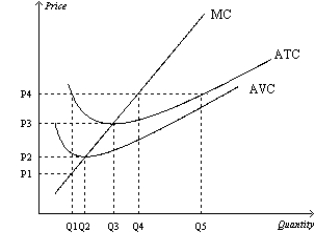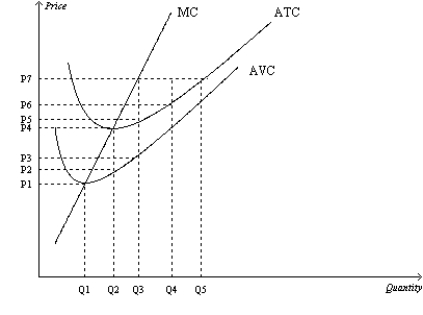A) can be represented by the area P3 × Q3.
B) can be represented by the area P3 × Q2.
C) can be represented by the area (P3-P2) × Q3.
D) is zero.
F) A) and B)
Correct Answer

verified
Correct Answer
verified
Multiple Choice
The textile industry is composed of a large number of small firms. In recent years, these firms have suffered economic losses, and many sellers have left the industry. Economic theory suggests that these conditions will
A) shift the demand curve outward so that price will rise to the level of production cost.
B) cause the remaining firms to collude so that they can produce more efficiently.
C) cause the market supply to decline and the price of textiles to rise.
D) cause firms in the textile industry to suffer long-run economic losses.
F) A) and B)
Correct Answer

verified
Correct Answer
verified
Multiple Choice
The assumption of a fixed number of firms is appropriate for analysis of
A) the short run but not the long run.
B) the long run but not the short run.
C) both the short run and the long run.
D) neither the short run nor the long run.
F) B) and C)
Correct Answer

verified
Correct Answer
verified
True/False
All competitive firms earn zero economic profit in both the short run and the long run.
B) False
Correct Answer

verified
Correct Answer
verified
Multiple Choice
Entry into a market by new firms will increase the
A) supply of the good.
B) profits of existing firms.
C) price of the good.
D) marginal cost of producing the good.
F) A) and D)
Correct Answer

verified
Correct Answer
verified
Multiple Choice
Which of the following is a characteristic of a competitive market?
A) There are many buyers but few sellers.
B) Many firms have market power because they own patents.
C) Buyers and sellers are price takers..
D) Firms sell differentiated products.
F) B) and C)
Correct Answer

verified
Correct Answer
verified
Multiple Choice
Table 14-10
Suppose that a firm in a competitive market faces the following revenues and costs:
 -Refer to Table 14-10. Which level of production in the table has the lowest average variable cost?
-Refer to Table 14-10. Which level of production in the table has the lowest average variable cost?
A) 1 unit
B) 2 units
C) 3 units
D) 4 units
F) B) and C)
Correct Answer

verified
Correct Answer
verified
Multiple Choice
In a competitive market, the actions of any single buyer or seller will
A) discourage entry by competitors.
B) influence the profits of other firms in the market.
C) have a negligible impact on the market price.
D) None of the above is correct.
F) None of the above
Correct Answer

verified
Correct Answer
verified
Multiple Choice
Figure 14-4
Suppose a firm operating in a competitive market has the following cost curves:  -Refer to Figure 14-4. At which price range will the firm continue to operate in the short run but earn negative profits?
-Refer to Figure 14-4. At which price range will the firm continue to operate in the short run but earn negative profits?
A) any price higher than P4
B) any price higher than P3 but less than P4
C) any price higher than P2 but less than P3
D) any price lower than P1
F) A) and C)
Correct Answer

verified
Correct Answer
verified
Multiple Choice
Suppose a firm in a competitive market produces and sells 8 units of output and has a marginal revenue of $8. What would be the firm's total revenue if it instead produced and sold 4 units of output?
A) $4
B) $8
C) $32
D) $64
F) A) and B)
Correct Answer

verified
Correct Answer
verified
Multiple Choice
Table 14-2
The table represents a demand curve faced by a firm in a competitive market.
 -Refer to Table 14-2. For this firm, the average revenue from selling 3 units is
-Refer to Table 14-2. For this firm, the average revenue from selling 3 units is
A) $12.
B) $4.
C) $3.
D) $1.
F) B) and D)
Correct Answer

verified
Correct Answer
verified
Multiple Choice
Consider a firm operating in a competitive market. The firm is producing 40 units of output, has an average total cost of production equal to $6, and is earning $240 economic profit in the short run. What is the current market price?
A) $0
B) $6
C) $10
D) $12
F) None of the above
Correct Answer

verified
Correct Answer
verified
Multiple Choice
When firms are neither entering nor exiting a perfectly competitive market,
A) total revenue must equal total variable cost for each firm.
B) economic profits must be zero.
C) price must equal average variable cost for each firm.
D) Both a and c are correct.
F) A) and C)
Correct Answer

verified
Correct Answer
verified
Multiple Choice
Table 14-13
Diana's Dress Emporium
 -Refer to Table 14-13. What is the marginal cost of the 1st unit?
-Refer to Table 14-13. What is the marginal cost of the 1st unit?
A) $50
B) $75
C) $80
D) $150
F) None of the above
Correct Answer

verified
Correct Answer
verified
Multiple Choice
Which of the following could be used to calculate the profit for a firm?
A) Profit = MR - MC
B) Profit = MR - TC
C) Profit = (P - MC) × Q
D) Profit = (P - ATC) × Q
F) All of the above
Correct Answer

verified
Correct Answer
verified
Multiple Choice
Table 14-11
Suppose that a firm in a competitive market faces the following prices and costs:
 -Refer to Table 14-11. If the firm is producing 3 units of output, it should produce
-Refer to Table 14-11. If the firm is producing 3 units of output, it should produce
A) more units of output because its marginal revenue is greater than its marginal cost.
B) fewer units of output because its marginal revenue is less than its marginal cost.
C) more units of output because its marginal revenue is less than its marginal cost.
D) fewer units of output because its marginal revenue is greater than its marginal cost.
F) A) and B)
Correct Answer

verified
Correct Answer
verified
Multiple Choice
Table 14-9
Suppose that a firm in a competitive market faces the following revenues and costs:
 -Refer to Table 14-9. If the firm's marginal cost is $11, it should
-Refer to Table 14-9. If the firm's marginal cost is $11, it should
A) increase production to maximize profit.
B) increase the price of the product to maximize profit.
C) advertise to attract additional buyers to maximize profit.
D) reduce production to increase profit.
F) None of the above
Correct Answer

verified
Correct Answer
verified
Multiple Choice
Figure 14-5
Suppose a firm operating in a competitive market has the following cost curves:  -Refer to Figure 14-5. In the short run, if the market price is P4, individual firms in a competitive industry will earn
-Refer to Figure 14-5. In the short run, if the market price is P4, individual firms in a competitive industry will earn
A) positive profits.
B) zero profits.
C) losses but will remain in business.
D) losses and will shut down.
F) None of the above
Correct Answer

verified
Correct Answer
verified
Multiple Choice
A market is competitive if (i) firms have the flexibility to price their own product. (ii) each buyer is small compared to the market. (iii) each seller is small compared to the market.
A) (i) and (ii) only
B) (i) and (iii) only
C) (ii) and (iii) only
D) (i) , (ii) , and (iii)
F) A) and B)
Correct Answer

verified
Correct Answer
verified
Multiple Choice
Table 14-6
The following table presents cost and revenue information for a firm operating in a competitive industry.
 -Refer to Table 14-6. What is the total revenue from selling 4 units?
-Refer to Table 14-6. What is the total revenue from selling 4 units?
A) $120
B) $257
C) $317
D) $480
F) B) and C)
Correct Answer

verified
Correct Answer
verified
Showing 81 - 100 of 543
Related Exams